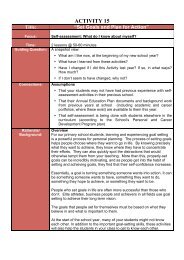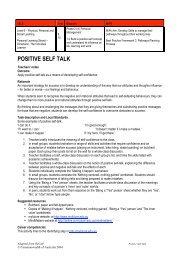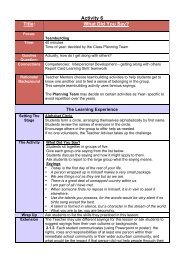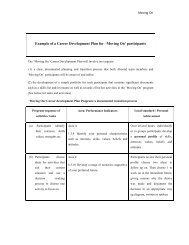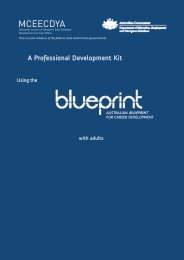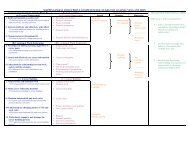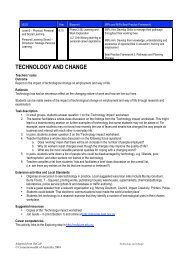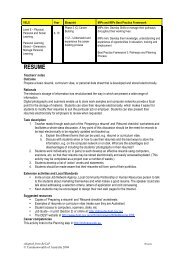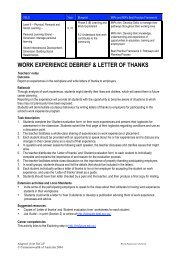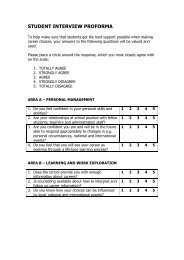Download - Blueprint - Australian Blueprint for Career Development
Download - Blueprint - Australian Blueprint for Career Development
Download - Blueprint - Australian Blueprint for Career Development
You also want an ePaper? Increase the reach of your titles
YUMPU automatically turns print PDFs into web optimized ePapers that Google loves.
<br />
Kirwan Senior High School<br />
What did the school set out to achieve <br />
Kirwan Senior High School has a particularly strong VET culture and a <br />
number of students from the school are the recipients of national and <br />
state awards. However, historically the courses offered at the school <br />
did not have strong links to the local labour market and some of the <br />
levels of competence were too simplistic. <br />
At the school, approximately 600 students go on work experience, <br />
which is particularly useful <strong>for</strong> re‐engaging those students who are <br />
losing direction and do not wish to be at school. Strong links with <br />
local industry partners had been established to make these work <br />
experiences possible <strong>for</strong> young people. Maintaining good <br />
relationships with industry partners was also critical to the program’s <br />
ongoing success. <br />
A major emphasis of the program was placed on providing realistic <br />
career options and practical experience <strong>for</strong> students, accompanied by <br />
skills that are recognised. It was felt that these factors were <br />
imperative <strong>for</strong> the future employability of young people in the school. <br />
The <strong>Blueprint</strong> gave trial <br />
participants a greater ability to <br />
articulate the learning outcomes <br />
of their career development <br />
activities.... <br />
<br />
....Resources should be treated <br />
as ‘living documents’ that are <br />
modified and adapted each year <br />
to suit group dynamics and the <br />
level of understanding of the <br />
cohort. <br />
The aim of this school project was to develop classroom materials <br />
that link to the <strong>Blueprint</strong> competencies and per<strong>for</strong>mance indicators. <br />
Worksheets, activities and a set of resources (including videos and PC <br />
resources) were developed and incorporated into the school’s Senior <br />
Education and Training plans <strong>for</strong> Year 11 and 12 students. <br />
What did they do <br />
The client group <strong>for</strong> the project was year 11 and 12 students <br />
undertaking vocational education pathways. Twenty percent of this <br />
cohort was made up of Indigenous students. Year 10 students were <br />
also involved, working on those competencies dealing with career <br />
pathways. <br />
The school’s guidance officers focused on the three competencies in <br />
Area A, and the VET teachers concentrated on developing learning <br />
strategies and worksheets <strong>for</strong> Areas B and C. Ongoing evaluation and <br />
feedback by all team members concerning the learning materials was <br />
also a feature of the project. <br />
The set of lesson plans and accompanying worksheets that have been <br />
developed are by nature generic and need to be modified <strong>for</strong> different <br />
client groups with specific needs (such as those with low literacy, those <br />
with little exposure / competence in Phases I and II of the <strong>Blueprint</strong> <br />
competencies, and <strong>for</strong> Indigenous and other cultural groups). The team <br />
believed that it is up to each school / teacher to modify the generic <br />
<br />
<br />
templates according to the needs of their client groups. (These and <br />
other resources are available to download from the <strong>Blueprint</strong> toolkit). <br />
Did the school find the <strong>Blueprint</strong> useful <br />
The school found that the <strong>Blueprint</strong> provided a tangible structure <strong>for</strong> <br />
their Vocational Pathways Program. <br />
It was, however, felt that in its prototype <strong>for</strong>m the <strong>Blueprint</strong> was <br />
cumbersome and overwhelming. Flexibility was seen as crucial to any <br />
successful implementation of the <strong>Blueprint</strong>: <br />
Flexibility is the key. Use existing resources and modify and/or <br />
adapt them to particular client groups. Resources should be <br />
treated as ‘living documents’ that are modified and adapted <br />
each year to suit group dynamics and the level of <br />
understanding of the cohort. <br />
On the whole the <strong>Blueprint</strong> gave the trial participants a greater ability <br />
to articulate the learning outcomes of their career development <br />
activities, and could provide the basis <strong>for</strong> a national qualification. <br />
<br />




